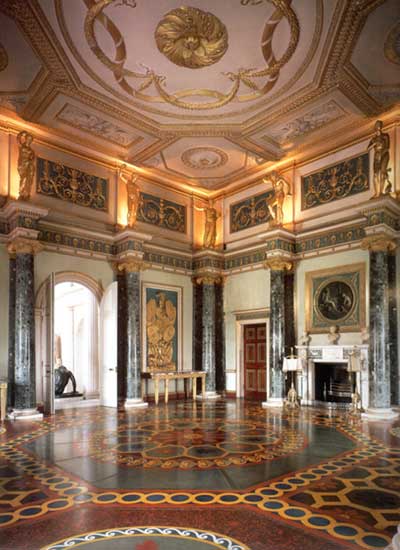Syon House and Park
 Outer London Attractions Outer London Attractions
with Burlington Bertie .

Syon House Ante Room. Photo courtesy of Syon House.
Venue: Syon House, Middlesex, TW8 8JF
Access House: House: 11am-5pm; Weds, Thurs, Suns, Bank Holiday Mons, Easter Weekend; 19 March - 26 October, 2008.
Access Garden: 10.30am-5pm; March - October, 2008. 10.30am-4pm; November 2008 - February, 2009.
Tickets House: £8. (Concessions).
Tickets Garden: £4. (Concessions).
Getting There: Road Map. London Transport: Tube to Gunnersbury, (District Line) and thence 237 or 267 bus. Rail: Waterloo - Kew Bridge and thence 237 0r 267 bus.
|
|
Described by the late Poet Laureate Sir John Betjeman as 'the Grand Architectural Walk', Syon House and its 200 acre park is the London home of the Dukes of Northumberland. The family has lived here for over 400 years and this magnificent palace remains the last surviving ducal residence complete with its country estate in Greater London.
Despite the serene classical splendour of its 18th century Robert Adam interiors, the history of Syon House and its occupants reflects the turbulent and bloody royal political tapestry of Tudor and Stuart times. Originally the site of a medieval abbey founded by Henry V in 1415 for the Bridgettine Order of nuns, it was one of the last great abbeys to be built. The Order was suppressed with some brutality and its enormous gothic abbey and lands sequestered by Henry VIII in 1539 during his dissolution of the monasteries following his spat with the Pope over his divorce. The King gave this rich Thames-side estate to his third wife's brother Edward Seymour, who rose to be Lord Protector of their young son King Edward VI on Henry's death and given the dukedom of Somerset. Demolishing the huge abbey church, (which was the size of a cathedral), Seymour began building Syon House in 1547 over part of the foundations, inspired by the emerging Italian Renaissance style that was shortly to beautify Royal London under the influence of architect Inigo Jones.
These were turbulently convoluted and politically dangerous times, where losers invariably lost their heads. Somerset lost his ennobled head to the Tower of London axeman in 1552 and Syon passed to the Dudleys, a rival ducal family with similar royal aspirations. It was here that Lady Jane Grey, a granddaughter of King Henry VII who had married a Dudley, was offered the crown, only to be beheaded herself together with her husband at the Tower in 1554 having been displaced by her cousin Mary Tudor, Henry VIII's eldest daughter.
In 1594, Henry Percy, 9th Earl of Northumberland, acquired Syon through marriage and although he himself spent 15 years imprisoned in the Tower by James I, (son of executed Mary Queen of Scots), on suspicion of treason, (his cousin was a leading member in the 1605 Guy Fawkes Gunpowder Plot), the Percy family continued to live there. The younger children of King Charles I lived with the 10th Earl at Syon House during the Civil War until forced to flee abroad following the King's execution in 1649.
In more settled Georgian times, the family prospered under royal patronage and in 1766 the Earl was elevated to the Dukedom of Northumberland. In 1762 he hired the Scottish architect, Robert Adam to remodel the old Syon mansion, to give both the exterior and interior a more fitting palatial aspect. It was to be Adam's early English masterpiece. At Syon House the architect initiated what later became known as the Adam style of interiors, incorporating ancient Roman decorative features with a revolutionary use of colour and a flexible attitude to the precise Classical rules of Palladianism that infuriated some of his contemporary architects but thrilled his discerning patrons. His classical manner remains an inspiration to this day.
The Duke also commissioned Northumbrian designer, Lancelot 'Capability' Brown, to lay out the grounds as a showpiece in the newly fashionable style of the English Landscape Movement. The crowning glory of Syon Park's gardens however, is Charles Fowler's Great Conservatory, built in 1826 for the third Duke's collection of exotica. It was the first conservatory to be built of metal and glass on such a large scale and was the inspiration for Caxton's Crystal Palace built to house the Great Exhibition of 1851.
Syon House with its Great Hall and magnificent rooms, together with its magnificent gardens and lake is now a popular venue for wedding and civil partnership ceremonies and receptions, dinners, balls, parties and corporate events. Its Adam interiors have been much used for film location in Regency costume dramas. Check the Syon Hospitality pages for hire rates.
Burlington Bertie's Verdict:
Syon House, nearby Osterley Park, and Kenwood House in North London are part of London's unique architectural heritage and are perhaps the most glorious of Robert Adam's work. They are all too often missed by visitors deterred by the short journey from London's West End and City; an unfortunate omission. The Syon House interior is ambitious and you can see here the width of Classical sources from which Adam drew; Palladianism, archaeological influences from contemporarily published works on digs in Palmyra, Baalbec, Athens, Pompeii, what was then classified as Etruscan work, and his own work on the ruins of the palace of Emperor Diocletian at Spalatro, (Split). An appreciation of Adam as a leader of the Neo-Classical movement in Europe and his continuing residual influence today on both sides of the Atlantic will be gained by a visit to at least one if not all three of these Adam masterpieces. As noted above, Syon House is available for private and corporate functions. I can think of few more perfect settings for a glamorous wedding, reception or appropriate film location.
Related Link
Kenwood House
|
© 2016 offtolondon.com All rights reserved.
Contact Us | |